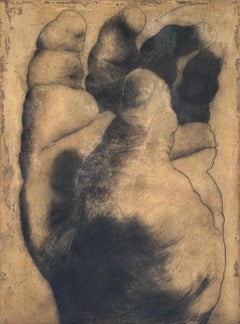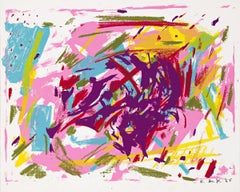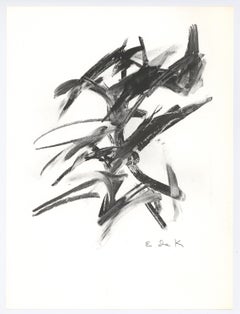Elaine de Kooning Art
Elaine de Kooning, the wife of Willem de Kooning, was a prolific and versatile painter, writer, and teacher.
Although she was a major figure in both the Abstract Expressionist and American Figurative Expressionist movements of the 1940s and 1950s, de Kooning eschewed developing a singular style and instead painted in a range of modes from realism to abstraction.
“Style is something I’ve always tried to avoid. I’m more interested in character,” de Kooning said. Her paintings feature loose, thick brushstrokes in bold hues executed in an energetic, improvisational mode. “A painting to me is primarily a verb, not a noun,” she famously declared, “an event first and only secondarily an image.”
Highly noted for her skill as a portraitist, de Kooning often painted friends and contemporary figures, notably including a commission to paint President John F. Kennedy.
Born on March 12, 1918 in Brooklyn, NY, she went on to study at Hunter College and the American Artists School. De Kooning quickly gained prominence in the burgeoning art scene, becoming a member of the infamous Eighth Street Club alongside Franz Kline, Clyfford Still and Hans Hofmann, solidifying her place within the canon of American Expressionism. She is regarded as being instrumental in developing contemporary American art, shaping young artists through several teaching positions held at influential institutions like the University of Pennsylvania and Yale University. De Kooning died on February 1, 1989 in Southampton, NY.
FInd Elaine de Kooning art today on 1stDIbs.
(Biography provided by Heather James Fine Art)
1980s Contemporary Elaine de Kooning Art
Masonite, Gesso, Charcoal
2010s Contemporary Elaine de Kooning Art
Canvas, Masonite, Oil
2010s Contemporary Elaine de Kooning Art
Gesso, Canvas, Mixed Media, Acrylic
2010s Contemporary Elaine de Kooning Art
Canvas, Masonite, Oil
2010s Contemporary Elaine de Kooning Art
Canvas, Mixed Media, Gesso, Acrylic
2010s Contemporary Elaine de Kooning Art
Gesso, Canvas, Mixed Media, Acrylic
21st Century and Contemporary Contemporary Elaine de Kooning Art
Masonite, Oil
2010s Contemporary Elaine de Kooning Art
Gesso, Canvas, Mixed Media, Acrylic
21st Century and Contemporary Contemporary Elaine de Kooning Art
Wood, Masonite, Acrylic
2010s Contemporary Elaine de Kooning Art
Gesso, Paint, Mixed Media, Acrylic, Board
Late 20th Century Contemporary Elaine de Kooning Art
Masonite, Acrylic
2010s Contemporary Elaine de Kooning Art
Gesso, Canvas, Mixed Media, Acrylic
2010s Contemporary Elaine de Kooning Art
Gold Leaf
1960s Abstract Expressionist Elaine de Kooning Art
Color, Screen
1960s Elaine de Kooning Art
Lithograph
1960s Abstract Expressionist Elaine de Kooning Art
Color, Screen
1960s Abstract Expressionist Elaine de Kooning Art
Aquatint
1960s Abstract Expressionist Elaine de Kooning Art
Aquatint
1960s Abstract Expressionist Elaine de Kooning Art
Aquatint
1960s Abstract Expressionist Elaine de Kooning Art
Aquatint
1960s Abstract Expressionist Elaine de Kooning Art
Aquatint
1960s Abstract Expressionist Elaine de Kooning Art
Aquatint
1960s Abstract Expressionist Elaine de Kooning Art
Aquatint
1960s Abstract Expressionist Elaine de Kooning Art
Aquatint
1970s Abstract Expressionist Elaine de Kooning Art
Lithograph
Elaine De Kooning art for sale on 1stDibs.
Artists Similar to Elaine de Kooning
- 1stDibs ExpertSeptember 16, 2024Interchange by Willem de Kooning is likely worth at least $300 million. That's how much the painting sold for through a private sale in 2015. De Kooning produced the painting in 1955 and sold it for just $5,000. The piece is an abstract landscape that uses bold colors, characteristic of his work in the Abstract Expressionist style. On 1stDibs, find a range of Willem de Kooning art.
![nude men [Bruce Sargeant (1898-1938)] Nude Male with Towel](https://a.1stdibscdn.com/mark-beard-paintings-bruce-sargeant-1898-1938-nude-male-with-towel-for-sale/a_9323/1642175973950/Beard_Bruce_Sargeant_1898_1938_Nude_Male_with_Towel_master.jpg?width=240)


